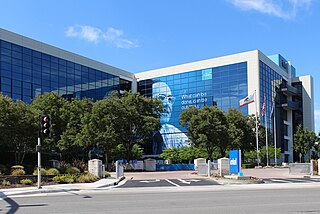Related Research Articles

Advanced Micro Devices, Inc. (AMD) is an American multinational corporation and fabless semiconductor company based in Santa Clara, California, that designs, develops and sells computer processors and related technologies for business and consumer markets.

The Cyrix 6x86 is a line of sixth-generation, 32-bit x86 microprocessors designed and released by Cyrix in 1995. Cyrix, being a fabless company, had the chips manufactured by IBM and SGS-Thomson. The 6x86 was made as a direct competitor to Intel's Pentium microprocessor line, and was pin compatible. During the 6x86's development, the majority of applications performed almost entirely integer operations. The designers foresaw that future applications would most likely maintain this instruction focus. So, to optimize the chip's performance for what they believed to be the most likely application of the CPU, the integer execution resources received most of the transistor budget. This would later prove to be a strategic mistake, as the popularity of the P5 Pentium caused many software developers to hand-optimize code in assembly language, to take advantage of the P5 Pentium's tightly pipelined and lower latency FPU. For example, the highly anticipated first-person shooter Quake used highly optimized assembly code designed almost entirely around the P5 Pentium's FPU. As a result, the P5 Pentium significantly outperformed other CPUs in the game.

Intel Corporation is an American multinational corporation and technology company headquartered in Santa Clara, California, and incorporated in Delaware. Intel designs, manufactures and sells computer components and related products for business and consumer markets. It is considered one of the world's largest semiconductor chip manufacturers by revenue and ranked in the Fortune 500 list of the largest United States corporations by revenue for nearly a decade, from 2007 to 2016 fiscal years, until it was removed from the ranking in 2018. In 2020, it was reinstated and ranked 45th, being the 7th-largest technology company in the ranking.

Itanium is a discontinued family of 64-bit Intel microprocessors that implement the Intel Itanium architecture. The Itanium architecture originated at Hewlett-Packard (HP), and was later jointly developed by HP and Intel. Launched in June 2001, Intel initially marketed the processors for enterprise servers and high-performance computing systems. In the concept phase, engineers said "we could run circles around PowerPC...we could kill the x86." Early predictions were that IA-64 would expand to the lower-end servers, supplanting Xeon, and eventually penetrate into the personal computers, eventually to supplant reduced instruction set computing (RISC) and complex instruction set computing (CISC) architectures for all general-purpose applications.

Sun Microsystems, Inc. was an American technology company that sold computers, computer components, software, and information technology services and created the Java programming language, the Solaris operating system, ZFS, the Network File System (NFS), and SPARC microprocessors. Sun contributed significantly to the evolution of several key computing technologies, among them Unix, RISC processors, thin client computing, and virtualized computing. Notable Sun acquisitions include Cray Business Systems Division, Storagetek, and Innotek GmbH, creators of VirtualBox. Sun was founded on February 24, 1982. At its height, the Sun headquarters were in Santa Clara, California, on the former west campus of the Agnews Developmental Center.

x86 is a family of complex instruction set computer (CISC) instruction set architectures initially developed by Intel based on the 8086 microprocessor and its 8-bit-external-bus variant, the 8088. The 8086 was introduced in 1978 as a fully 16-bit extension of 8-bit Intel's 8080 microprocessor, with memory segmentation as a solution for addressing more memory than can be covered by a plain 16-bit address. The term "x86" came into being because the names of several successors to Intel's 8086 processor end in "86", including the 80186, 80286, 80386 and 80486. Colloquially, their names were "186", "286", "386" and "486".

Wintel is the partnership of Microsoft Windows and Intel producing personal computers using Intel x86-compatible processors running Microsoft Windows.
Transmeta Corporation was an American fabless semiconductor company based in Santa Clara, California. It developed low power x86 compatible microprocessors based on a VLIW core and a software layer called Code Morphing Software.

The Transmeta Crusoe is a family of x86-compatible microprocessors developed by Transmeta and introduced in 2000.

A mobile processor is a microprocessor designed for mobile devices such as laptops, and cell phones.
Walter Jeremiah Sanders III is an American businessman and engineer who was a co-founder and long-time CEO of the American semiconductor manufacturer Advanced Micro Devices (AMD), serving in the position from 1969 to 2002.

The Mac transition to Intel processors was the process of switching the central processing units (CPUs) of Apple's line of Mac and Xserve computers from PowerPC processors over to Intel's x86-64 processors. The change was announced at the 2005 Worldwide Developers Conference (WWDC) by then-Apple CEO Steve Jobs, who said Apple would gradually stop using PowerPC microprocessors supplied by Freescale and IBM.

Sun Fire is a series of server computers introduced in 2001 by Sun Microsystems. The Sun Fire branding coincided with the introduction of the UltraSPARC III processor, superseding the UltraSPARC II-based Sun Enterprise series. In 2003, Sun broadened the Sun Fire brand, introducing Sun Fire servers using the Intel Xeon processor. In 2004, these early Intel Xeon models were superseded by models powered by AMD Opteron processors. Also in 2004, Sun introduced Sun Fire servers powered by the UltraSPARC IV dual-core processor. In 2007, Sun again introduced Intel Xeon Sun Fire servers, while continuing to offer the AMD Opteron versions as well.
P. A. Semi was an American fabless semiconductor company founded in Santa Clara, California in 2003 by Daniel W. Dobberpuhl, who was previously the lead designer for the DEC Alpha 21064 and StrongARM processors. The company employed a 150-person engineering team which included people who had previously worked on processors like Itanium, Opteron and UltraSPARC. Apple Inc acquired P.A. Semi for $278 million in April 2008.
Consumer Ultra-Low Voltage (CULV) is a computing platform developed by Intel. It was estimated in January 2009 that this market could reach 10 million CULV laptops shipped during that year. Competing platforms are the VIA Nano, AMD Yukon, AMD Nile notebook platform, and graphic chips from the Nvidia GeForce line within the "Nvidia Ion platform". Some of the lowest-power-consumption processors for the ultra thin CULV category are only a few watts more than the Intel Atom, which is rated at no more than 2.5 W. Because of their low power and heat output, CULV enables very thin computer systems, and long battery life in notebook computers, such as those designed to Intel's Ultrabook specifications.
James B. Keller is an American microprocessor engineer best known for his work at AMD, Apple, and Tesla. He was the lead architect of the AMD K8 microarchitecture and was involved in designing the Athlon (K7) and Apple A4/A5 processors. He was also the coauthor of the specifications for the x86-64 instruction set and HyperTransport interconnect. From 2012 to 2015 he returned to AMD to work on the AMD K12 and Zen microarchitectures.
A. Thampy Thomas is an electrical engineer who contributed to microprocessor pipeline architecture and founded semiconductor company NexGen microsystems.

The Mac transition to Apple silicon was the transitioning of Apple Inc.'s line of Mac computers from designs using Intel x86-64 CPUs to designs based on Apple-designed processors based on the ARM64 architecture.
References
- ↑ Kanellos, Michael (15 February 2008). "Secret recipe inside Intel's latest competitor". CNET .
- 1 2 "Cal-EASI Database".
- 1 2 Vance, Ashlee (24 April 2008). "Sun buys low-power x86 disaster Montalvo". The Register .
- ↑ Takahashi, Dean (20 March 2008). "Montalvo seeking a hoard of cash to avoid shutdown". VentureBeat .
- ↑ Kanellos, Michael (1 January 2008). "Sun close to buying Intel would-be competitor Montalvo". CNET .